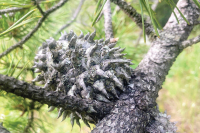Smokies species count reaches 20,000
 A bee lands on a yellow passion flower. Katherine Parys photo
A bee lands on a yellow passion flower. Katherine Parys photo
The Great Smoky Mountains National Park has reached a biodiversity milestone with the discovery and documentation of 20,000 species of plants, animals and other organisms in the park since the All Taxa Biodiversity Inventory launched 21 years ago.
“Reaching this milestone is a testament to the curiosity, tenacity and dedication of the biological community,” said Superintendent Cassius Cash. “Each year, we have scientists who share their time and expertise to help us better describe, understand and protect the wonders of the Smokies.”
The ATBI, managed by the nonprofit Discover Life in America, has documented more than 9,500 new species records for the park and an additional 1,006 species that are completely new to science. Among the newest species records in the park are the giant bark aphid (Longistigma caryae), which is the largest aphid in the U.S.; the Blue Ridge three-lobed coneflower (Rudbeckia triloba var. rupestris), a handsome wildflower native to Kentucky, Tennessee and North Carolina; the frosted elfin butterfly (Callophrys irus), a rare butterfly whose caterpillars feed on lupine and indigo; and the yellow passion flower bee (Anthemurgus passiflorae), which exclusively pollinates the small flowers of the yellow passion flower. In addition, the nine-banded armadillo (Dasypus novemcinctus) was recently documented in the park for the first time.
Visitors can help the effort by recording species observations as part of the Species SnapIt & MapIt project using the phone app iNaturalist. More information is available at www.dlia.org/snapit-mapit.









